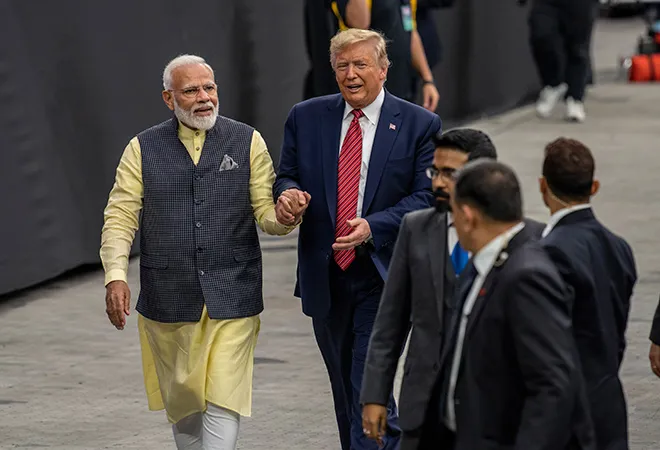-
CENTRES
Progammes & Centres
Location
The India-US trade relations have been gaining momentum over the years, especially in merchandise trade. India has a trade surplus of $31 billion with the US.

Image Source: Sergio Flores/Getty
With exports doing poorly for months and the Indian economy requiring a speedy revival, it is a welcome move that the India-US trade talks have resumed again after a stalemate in September 2019. In September, US President Donald Trump had announced: “I think very soon we’ll have a trade deal.” This was after talks began between top trade officials of the two countries which later fell through. Again, in November, India’s Commerce Minister began talks with his counterpart while visiting the US. There is some hope of a trade deal before the end of the year.
There is much scope for enhancing the bilateral trade, and India can try to persuade the US to revoke the removal of GSP on Indian exports imposed since June. The removal of GSP will cost India dearly as it allows $6.3 billion of goods to enter US duty free.
The India-US trade relations, however, have been gaining momentum over the years, especially in merchandise trade. India has a trade surplus of $31 billion with the US — a bone of contention for President Trump. The bilateral trade in goods and services grew at an average rate of 7.59 per cent from $68.4 billion to $142 billion. The US is India’s second biggest trade partner and the bonhomie between President Trump and Prime Minister Modi in Houston indicated that the time was ripe for striking a trade deal between the two countries. Yet, Trump has remained acerbic and unhappy about India’s high duties, calling India the “tariff king” specially regarding the high duties on Harley Davidson motorcycles from the US. Trump has been insisting on greater access to Indian markets for its various exports.
According to a report published by the Atlantic Council and India US strategic Partnership Forum by Mark Linscott, a former trade official of the Trump administration, the two countries should be able to manage current challenges and address those that are likely to surface in the future. Otherwise the two countries are at a crossroads, with one direction leading to an initial bilateral agreement, but the other to outright conflict. They need to cultivate trust and achieve confidence building measures as both countries are showing signs of growing protectionism which is only exacerbating tensions.
The new trade deal, however, will have to resolve the sticky points and there seem to be a near solution as Piyush Goyal announced at the US-India Strategic Forum in Washington DC that US Trade Representative Ambassador Robert Lighthizer and he have almost “resolved the broad contours of what was going to be announced.” Recently the two parties have come down to discussing duty cuts on 40 goods, including apples, almonds and mobile phones, smart watches and engineering goods.
US specifically has sought duty cut on pulses and has complained to the WTO, along with Australia and Canada, as to why India has banned the import of certain pulses. The US thinks this is because India wants to control fall in prices of its own domestic produce.
US has also demanded unconditional market access for dairy products which India has not been able to grant because of religious and cultural reasons. The US cows are fed with animal feeds or blood meal made of blood from cattle and pigs in order to give them a high protein dietary supplement which increases milk output. This practice is not acceptable to Indians. For protecting religious sensitivities, now dairy is out of India-US talks.
India requires certification that animals have never been fed blood meal. If India provided market access to dairy exports, US exports would rise by $100 million. Yet, it is an avenue which is likely to remain closed. India also wants easier certification for its fruit exports like grapes and pomegranates for better market access to the US market.
The US is insisting on duty cuts on certain US imports like medical devices into India and that India should have no price control on them. The growth in the imports of medical devices from the US has been quite impressive — the US being the main supplier. Imports of such devices rose by 24 per cent to Rs 38, 837 crore in FY 19. The government slashed the prices of medical devices by 85 per cent and capped the trade margins for coronary stents in 2017. This is because the Indian government equated high trade margins to ‘illegal profiteering.’ It capped the prices of high-end heart stents (small wire mesh structures used to treat blocked arteries) at around $450 compared to $3,000 charged earlier. This was followed up with a round of price controls on knee implants. The government defended its move, saying it had imposed price control to rein in unethical practices and trade distortionary measures in the industry. Many US companies were hit like Boston Scientific, Stryker and Johnson and Johnson.
The government can relent a bit on the price controls, but it is unlikely to give it up entirely because it has been seen to benefit the common person whose extra medical expenses come from his/her own pocket. India has one of the highest Out of Pocket expenditures and patients pay up to 61 per cent of the medical expenses from their own savings, leading many to penury in case of diseases like cancer and heart problems. The National Pharmaceutical Pricing Authority has been pushing for more controls.
On the whole, it seems that the bilateral relationship is at an important juncture. If the deal goes through, it will help to expand India’s exports, especially if the GSP withdrawal is revoked. Otherwise, there can be a tit-for-tat retaliatory war like the one US is currently engaged in with China. The US is also an important investor and highest source of FDI ($3.13 billion in 2018-19). If the trade deal is concluded, then an investment deal can follow. India needs to increase employment which only manufacturing can provide and rise in exports is imperative for it.
Both countries have to review their priorities, and the US should not treat India based on the size of its GDP alone. The per capita income of India is one seventeenth of the US’s per capita income — and the ‘affordability’ question is important.
The views expressed above belong to the author(s). ORF research and analyses now available on Telegram! Click here to access our curated content — blogs, longforms and interviews.

Jayshree Sengupta was a Senior Fellow (Associate) with ORF's Economy and Growth Programme. Her work focuses on the Indian economy and development, regional cooperation related ...
Read More +